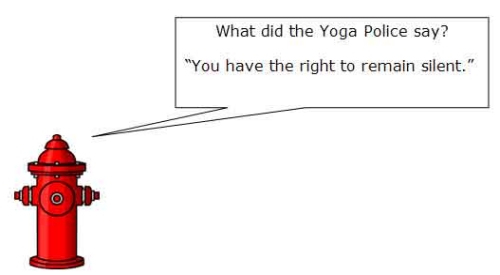By Claire Diab and Dennis Boyle
 Meditation is a powerful tool to incorporate into your daily life, bringing you clarity, a peaceful mind, better concentration, a sense of well being, and increased energy. Meditation is synonymous with yoga and, in reality, is an integral part of any yoga practice. The forefather of yoga, Patanjali, in his systemic approach to yoga categorizes yoga as having eight limbs. Of the eight limbs, meditation is the water that awakens and nourishes the quiet spirit within. A famous western yogi often said that meditation was like “watering the root to enjoy the fruit.”1 A regular meditation practice enhances and accelerates the progress firefighters will reap from their yoga practice.
Meditation is a powerful tool to incorporate into your daily life, bringing you clarity, a peaceful mind, better concentration, a sense of well being, and increased energy. Meditation is synonymous with yoga and, in reality, is an integral part of any yoga practice. The forefather of yoga, Patanjali, in his systemic approach to yoga categorizes yoga as having eight limbs. Of the eight limbs, meditation is the water that awakens and nourishes the quiet spirit within. A famous western yogi often said that meditation was like “watering the root to enjoy the fruit.”1 A regular meditation practice enhances and accelerates the progress firefighters will reap from their yoga practice.
It is important to understand that meditation incorporates a wide range of disciplines, all with healthy results. Each type of meditation is beneficial to practice. Jeanne Ball, a writer for the David Lynch Foundation, outlines three major types of meditation and gives a brief explanation of the benefits.
Controlled focus: Classic examples of concentration or controlled focus are found in the revered traditions of Zen, Tibetan Buddhism, Qiqong, Yoga, Christianity, and Vedanta, though many methods involve attempts to control or direct the mind. Attention is focused on an object of meditation–such as one’s breath, an idea or image, or an emotion. Brain waves recorded during these practices are typically in the gamma frequency (20-50 Hz), seen whenever you concentrate or during “active” cognitive processing.2
Open monitoring: These mindfulness type practices, common in Vipassana and Zazen, involve watching or actively paying attention to experiences–without judging, reacting, or holding on. Open monitoring gives rise to frontal theta (4-8 Hz), an EEG pattern commonly seen during memory tasks or reflection on mental concepts.3
Automatic self-transcending: This category describes practices designed to go beyond their own mental activity–enabling the mind to spontaneously transcend the process of meditation itself. Whereas concentration and open monitoring require degrees of effort or directed focus to sustain the activity of meditation, this approach is effortless because there is no attempt to direct attention–no controlled cognitive processing. The EEG pattern of this category is frontal alpha coherence, associated with a distinct state of relaxed inner wakefulness.4,5
Practitioners of mantra meditation techniques describe the above measured benefits as easy to achieve, because the techniques are effortless in their practice. Patanjali’s Yoga Sutras states in the second sutra, “Yoga is the complete settling of the activity of the mind.” A mantra meditation technique takes the mind effortlessly to that state of “complete settling of the mind.”

If you are unable to learn a mantra meditation from a qualified teacher, then the So Hum meditation described below will settle the mind and take it to the state of “pure awareness.”
So Hum Meditation:
Experiences during meditation will fall into four categories: (1) Repeating the mantra, (2) having thoughts, (3) falling asleep, or (4) experiencing pure awareness. Keep these guidelines in mind.
A. Repeat the mantra easily and effortlessly. It may change, become vague, or follow a certain rhythm. Just let it go and experience any changes innocently.
B. If you notice that your attention has drifted away from the mantra to thoughts, sensations in the body, or noise in the environment, gently bring your awareness back to the mantra.
C. If you fall asleep, it is OK. The body will naturally take the rest it needs. When you notice that you have been asleep, just return to the mantra. If your meditation time is up, spend a few minutes repeating the mantra before stopping and coming out of meditation.
Meditation is not for tuning out; it is for tuning in. It is not for getting away from it all; it is for getting in touch with it all. You will find that the value of meditation is not found specifically in meditation but in a more enjoyable and fulfilling life. We encourage you to begin a regular meditation practice and begin the process of experiencing your true self, which is kind, compassionate, lighthearted, understanding, creative, brilliant, calm, and focused.
Meditation instruction is also on two DVDs by Claire Diab: “Breathe, Move, Meditate,” and “Yoga For Weight Loss,” available at: www.clairediab.com.
REFERENCES
1. Maharishi Mahesh Yogi.
2. Lutz, Greischar, Rawlings, Ricard, Davidson, 2004. Proc Natl Acad Sci U S A 101,16369-73.
3. Cahn, Delorme, & Polich, 2010. Cognitive Processing 2010 11(1):39-56.
4. Travis et al, 2010. Cognitive Processing 11(1), 21-30.
5. http://www.huffingtonpost.com/jeanne-ball/how-meditation-techniques_b_735561.html
6. http://www.tm.org/benefits-of-meditation
7. http://www.cbeprograms.org/brain_development/research/index.html
8. Dr. Deepak Chopra & Dr. David Simon “The Seven Spiritual Laws of Yoga” pgs. 90-92.
For more information, visit www.yoga4firefighters.com.
BIOS
Claire Diab is an internationally recognized Yoga therapist. She is the director of the Yoga Program for the Chopra Center founded by Dr. Deepak Chopra and Dr. David Simon. She is an adjunct professor of Asian Studies at Seton Hall University. She is the author of several books and DVDs on Yoga including “Yoga For Firefighters.”
Dennis Boyle is a retired fire director and acting chief with the West Orange (NJ) Fire Department. He was the recipient of the 1999 New Jersey Deputy Fire Chiefs “Fire Officer of the Year” award.

